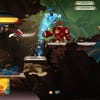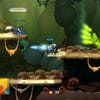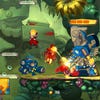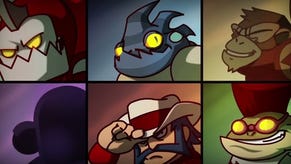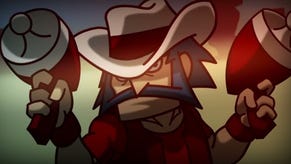Awesomenauts Review
DOTA upon me.
Often, ahead of a multiplayer game's release, reviewers are offered a scheduled time to meet with and compete against members of the development team online in order to approximate the general public's experience. It's never quite a 'true' approximation, of course, as the developers have the benefit of months, perhaps years of experience with their creation - and all of the intimate knowledge of strategies, shortcuts and cheats that come with it.
The reviewer, meanwhile, arrives at the game fresh and inexperienced, groping through the systems, always playing catch-up. Shrewd developers account for this disparity, handicapping themselves in order to level the playing field and allow the newcomer to feel a sense of progress. After all, even the least petulant player eventually tires from repeated losses at the hands of an expert.
"Will you please stop rushing the enemy and giving them free resources. Heal more."
Jasper from Ronimo's Xbox Live message was sharp, snappy and made little attempt to mask his frustration at my inexperience - a greenness that was threatening to cost us the match. It's the kind of frank exchange that happens every day when playing in the wilds of Xbox Live (albeit usually seasoned with more racism and expletives) but one rarely delivered by a game developer wearing kid gloves while trying to provide a reviewer with the best possible online experience.
But Awesomenauts is the kind of game that raises tension between players who fail to work together as a team, and Ronimo Games cares too much about Awesomenauts to deal in niceties. The message reveals two important things: the developer's passion, not only for the game but also for the sense of competition and comradeship the game fosters; and Awesomnauts' capacity to raise passions to fever pitch. And Jasper was right. I was rushing the enemy too much, giving away free resources in my gung-ho play style, and, ultimately, losing us the match. Sore from the reprimand, I changed tactics - and we found victory.
MOBA - short for Multiplayer Online Battle Arena - is a clunky umbrella term, but the style of game it represents is anything but marginal. Riot Games' League of Legends, the preeminent MOBA, is the biggest game in the world today, its community dwarfing even that of Minecraft - some feat for a style of game that arose from a Warcraft mod released in 2003.
Wherever there is creative success, creative subversion is quick to follow, and Awesomenauts is a 2D indie cartoon antidote to the po-faced, inscrutably nerdish visuals of that original mod, Defense of the Ancients, and its ilk. It's the first 2D, side-scrolling MOBA, the sharp competitive core of the genre softened with a 1980s Saturday morning cartoon aesthetic and giant, pin-sharp sprites that ooze character and humour. There's Clunk, a hulking, slow-paced brute who can self-detonate in order to splash damage anyone in the vicinity; Lonestar, a gun-toting cowboy who throws sticks of dynamite; and Leon, a short Gallic freak whose character select soundtrack is a parody of a 'Je t'aime' waltz.
The colourful cast and clean presentation ease players into what is, despite the nuanced tactics and character match-ups, a largely straightforward game of domination. Two teams of three characters must protect a 'drillcore', the unprotected heart of their base, while simultaneously attempting to destroy the opposing team's drillcore in order to win the match.
Wall-mounted gun turrets impede that progress, acting as vicious gates that must be hacked away at before they explode and grant a few metres further passage towards your goal. Run at one of these turrets without protection and its bullets will tear through your health bar in seconds. However, AI-controlled droids are deployed from your base every few seconds, trundling relentlessly towards the heart of the enemy base. Approach a turret from behind one of these droids and you're afforded a few seconds' attack time as they activate their shields and absorb the bullets as a short-lived decoy.
It's almost always beneficial to find a way to replenish your health after staging an attack, rather than allowing yourself to be destroyed and re-entering the battlefield. For one, there's always a pause of a few seconds before your character respawns and, when they do, there's a 20-second deployment micro-game sequence as you're fired from your team's spaceship above the planet onto the battlefield (during which you can collect some extra cash by successfully steering your pod).
To avoid this time-consuming penalty, you can teleport back to the health-restoring home base at any point by holding down the right bumper for a few seconds. Take damage while doing so and the teleportation animation will be reset, so it's imperative to find a quiet spot before you attempt this. Alternatively, health packs are dotted around the map or you can destroy the local critters that hop about the playfield for health drops.
While both teams start off evenly matched, the balance of power shifts as each team earns Solar, Awesomenauts' currency, used to upgrade your character over the course of a match. You automatically earn Solar just by staying alive, while deposits can also be picked up from around the battlefield or earned by defeating enemies. To spend Solar you must return to your base, where a shop will allow you to upgrade a wide range of different character abilities.
It's in these details that the game's nuances begin to reveal themselves, as you must make strategic choices on whether to increase your health, add a buff to the amount of Solar you earn or spend all of your cash on upgrading specific abilities. The cat's cradle of strategic possibilities here, and the way in which they slot into the wider framework of the match, makes every game feel distinct and is where the heart of the game's tactical potential rests.
The six characters (three of whom are unlocked as you level up your profile through repeat play - with more promised post-launch) all have different strengths and weaknesses, and creating a well-balanced team between the three of you is crucial to high-level play. Maps are well thought through and filled with interesting features, such as a bridge over troubled water, home to a snapping monster who rises from the depths with hungry jaws if any player jumps on a nearby summon button.
There are some problems, however. Matches routinely take too long to play out (especially between two evenly-matched teams), an issue that would have been solved had Ronimo added a default time limit and allowed draw matches. Likewise, the feedback when you land an attack is often lacking. Victory can feel like death by a thousand cuts, as every strike chips away at a turret's health. There's never that sense of bristling satisfaction when landing a screen-filling final blow, merely the sense that you limped over a finish line.
Nevertheless, Awesomenauts is a tough game to walk away from, with a just-one-more-go dynamic that tugs you back in, time and again. Ronimo's typically squeaky-clean presentation makes this a pleasant game to splash about in, but don't mistake the bright, saturated colours for a lack of strategic maturity. This is a deep, engaging, beautiful game, a welcome alternative to DOTA and League of Legends for the console crowd.


